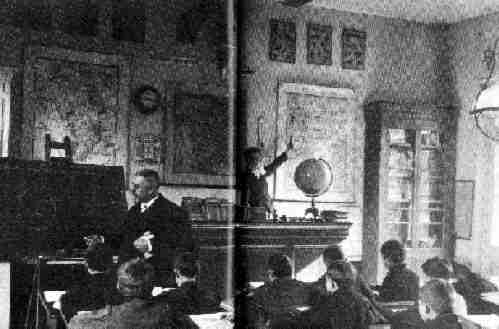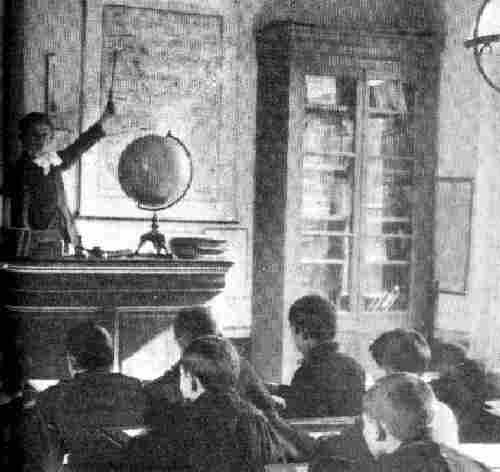
Figure 1.--This staged photograph still provides a feeling for a French classroom in the early 1900s. I'm not sure, however, if these are the older primary students or the younger secondary students.


Figure 1.--This staged photograph still provides a feeling for a French classroom in the early 1900s. I'm not sure, however, if these are the older primary students or the younger secondary students. |
HBC is attempting to assess French schoolwear trends. We have assembled a good deal of information on different types of garments, but an accurate assessment of trends over time and conventions remains elusive. Thus HBC is assembling images of invidual schools. One a number of schools have been assesmbled it will enable us to better understand trends over time and accepted conventions. Unfortunately often little information is available on the schools pictured in many available images. HBC will do its best to assess these images. Hopefully our French consultants will be able to add additional details.
I'm not sure, however, if these are the older primary students or the younger secondary students. Given the apoints in the classroom I think it might be a junior class in a secondary school. It is an all boys school. HBC believes that most French schools until after World War II (1939-45) were single gender schools, but there were some coed schools as well. While the source identifies this photograph only as ecole de garçons, it does indicate that it was located at Ault (Somme).
HBC notes that this photograph was taken in 1903.
The children in this class appear to be about 12 or 13 years old, perhaps 11 years. It is very difficult, however, to tell from the back. The classroom looks much more interesting and well appointed than many we have seen. There are maps, wall pictures, a globe, bookcasem clock, and other items. Despite the obviously staged sceen, this photograph still provides a feeling for a French classroom in the 1910s.

Figure 2.--This looks like a very well appointed classroom. Note the white bow that the boy at the front wears. |
The teacher is a rather serious looking man, almost a stereotype of a French school master. Men were much more likely to be school teachers than is the case today. At the bottom of the page he conductsd what looks to be a geometry class. When he finished that lessdon, you can almost see him launch into a tirade about Germany and the need to free "Alsace Loraine from the embrace of the Hun".
The boys in this class are wearing a variety of clothes providing some intersting insights into early 20th century French schoolwear. The clothing is mot well displayed in this photograph, but it does give a good idea of how a French classroom looked in the dearly 20th century.
None of the headwear worn by the boys is shown in the photograph. It is likely though that some of the boys wore berets.
While the photograph is not as clear as would be desired, about half the class appears to be wearing smocks. Smocks were clearly quite common in French schools at the time, altjhough this image suggest that they were not universal and not all schools insisted on them. At this school, it was apparently up to the parents.
Collars: As is the case of most French school smocks, there is no destinctive collar.
Buttoning: It is not possible to make out details on all the smocks, but some are clearly back buttoning. All of the smocks the children are wearing are also probably back buttoning but it can not be confirmed. I am not sure that they front buttoning smocks were even available before World War I.
Color: All of the boys in smocks wear identically colored dark smnocks, either black or dark blue.
Pattern: All of the smocks shown are solid colors, no patterns.
Belts: Many but not all French boys wore their smocks with belts outside the smock. It is not possibly, however, to see how these boys are wearing their belts.
Length: French children wore smocks at different length. It is not possible to tell in this image what length smocks the boys are wearing.
Some of the boys appear to be wearing jackets rather than smocks. It is sometimes difficult to tell, but any suggestion of a collar probably means a jacket.
The type of trousers the boys are wearing can not be determined, bit it would presumably be kneepants.
French boys often wore their smocks without fancy bows. Some younger boys more commonly wore bows with smocks. Some of these boys appear to be wearing white bows, but with theview from the back it is difficult to determine. The bows probably mean the images was taken in the early 1910s if not the late 1900s. I'm not quite sure just what age boys in France still war bows, but believe that it was not uncommon for boys this age to wear them when dressing up.
French schools boys are noted for their book bags and the extensive hime work requiring memorization given by demanding masters. No the book bags, however, can be seen in this photograph, presumably they are all tucked away under the benches.
The boys mostly wear similar length hair styles. All wear short hair, although some appear to have almost cropped hair short cuts. This almost suggests a school rule. A couple boys, however, have more unkempt looking hair.
Related Chronolgy Pages in the Boys' Historical Web Site
[Main Chronology Page]
[The 1840s]
[The 1850s]
[The 1860s]
[The 1870s]
[The 1880s]
[The 1890s]
[The 1900s]
[The 1910s]
[The 1920s]
[The 1930s]
Related Style Pages in the Boys' Historical Web Site
[Return to the Main French individual school page]
[Return to the Main French school page]
[Main school uniform page]
[Main country page]
[Smocks]
[Berets]
[Knee pants suits]
[Short pants suits]
[Stockings]
[Eton suits]
[Jacket and trousers]
[Blazer]
[School sandals]
